The Arts on Stamps of the World —October 1
An Arts Fuse regular feature: the arts on stamps of the world.
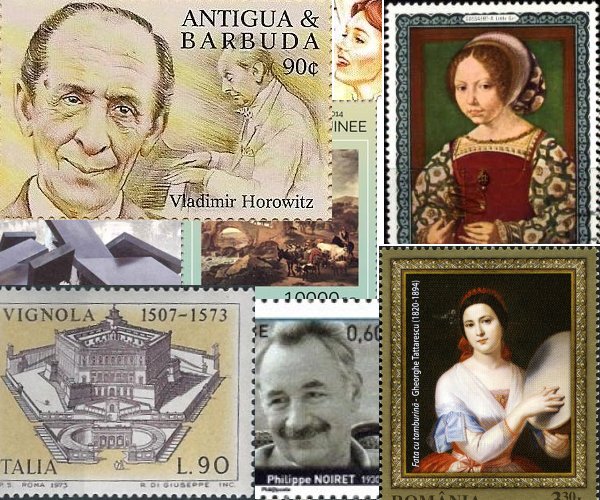
By Doug Briscoe
It’s another busy day for The Arts on Stamps of the World, with the biggest names being those of Vladimir Horowitz, Paul Dukas, Philippe Noiret, and Julie Andrews. But we have fourteen more artists—painters, composers, writers, and an architect—on the docket.
It is perhaps remarkable that two of the very greatest instrumentalists of the 20th century were born a day (and five years) apart. Yesterday was the birthday of David Oistrakh, today we celebrate Vladimir Horowitz, born on October 1 (O.S. September 18), 1903, in Kiev. His parents were well-to-do assimilated Jews, and Horowitz himself was nonobservant for most of his life. He had an uncle who was a close friend of Scriabin. He gave his first public recital at age 17 in Kharkiv and made his US debut at Carnegie Hall in 1928. Two years later he made the world première recording (abridged) of Rachmaninoff’s Third Piano Concerto with Albert Coates. He married Toscanini’s daughter Wanda in 1933, although there are indications he was gay. He once famously quipped, “There are three kinds of pianists: Jewish pianists, homosexual pianists, and bad pianists.” Among his very small number of students were Byron Janis, Gary Graffman, and Ivan Davis. He died, aged 86, on November 5, 1989 in New York City and was buried in the Toscanini family tomb in Milan.
Now we turn to the first of our four (!) painters representing the Low Countries. French-speaking Jan Gossaert, born about 1478, died on this day in 1532. He went by a variety of names: the original spelling was the French Gossart, the Dutch version apparently superseded that only posthumously; he also went by Jan Mabuse (from his birthplace of Maubeuge) and Jennyn van Hennegouwe (Hainaut), the name he gave when he was admitted to the Antwerp Guild of Saint Luke in 1503. He was one of the first northern painters to visit Rome (1508-09), when he seems to have accompanied a diplomatic mission to Pope Julius II. This exposure (you should pardon the double entendre) to Italian art led Gossaert to introduce nudity into both allegorical and religious painting in the North. See, for example, the Belgian monochrome stamp, or better, the original painting of the first of our four Madonnas (undated). The next two are both US Christmas issues, one dated 1525, from 2002, and the other, Virgin and Child in Landscape (undated?), from 2013. Finally, Madonna-wise, comes a Spanish reproduction of a 1515-16 Madonna held in the Prado. The portrait stamp from Ras al Khaima depicts A Young Princess (possibly Dorothea of Denmark; c1520-30), and the sheetlet from Congo-Kinshasa gives us three representations of Adam and Eve: the first from circa 1520; the one at upper right from 1525, and the third, decidedly animated pair from c1525-30. The last picture is one of Neptune and Amphitrite (1516). I can’t resist quoting the author of the Wikipedia article regarding this painting: “It is difficult to find anything more coarse or misshapen than the Amphitrite, unless it is the grotesque and ungainly drayman who figures for Neptune.” To vindicate the master, there is also a fine Self-Portrait dated c1515-20.
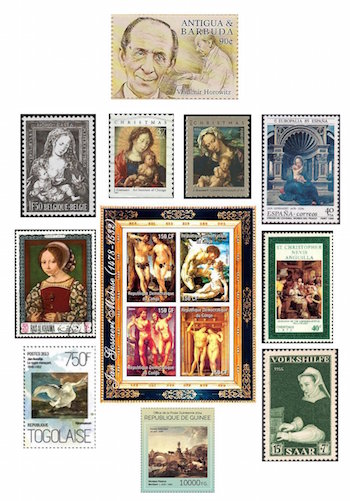
Next up is Frans Floris (1517 – 1 October 1570), who also died on this date 41 years after Gossaert. Known also as Frans Floris the Elder or Frans Floris de Vriendt, he was a Flemish painter whose brothers were diversified in the arts—one was a architect and sculptor, one a painter of stained-glass windows, and the third a potter. Like Gossaert, he became a member of the Guild of Saint Luke in Antwerp. This was in 1539-40, after which Floris made his own excursion to Italy, returning in 1545. Much of Floris’s work has been lost, some of it as the result of Calvinist fanaticism. He appears to have stopped painting after 1566, possibly as a consequence of seeing so much of his work destroyed. The only stamps for Floris I could find are one from Anguilla of Adoration of the Shepherds (1568) and, directly beneath it, a detail of a woman playing the spinet from a Family Portrait dated 1561. I link also to The Awakening of the Arts and The Fall of Man (both c1560).
Again, for the Dutchman Jan Asselijn (c1610 – October 1, 1652), as for Gossaert and Floris, we are acknowledging his date of death rather than his (unknown) birthday. He was born in Dieppe and also made the obligatory Italian journey as part of his artistic education. It seems he had a withered hand, which earned him the cruel nickname Krabbetje (little claw) among his colleagues. His image was captured in an etching by Rembrandt. Asselijn’s most celebrated painting is The Threatened Swan, in which some have seen an allegory for Dutch national spirit in the face of danger. It’s on a stamp from Togo.
The last figure in today’s quartet of painters from the Low Countries is Nicolaes Pieterszoon Berchem (1 October 1620 – 18 February 1683), and, for a change, today is his birthday. He came from Haarlem and was the son of the painter Pieter Claesz, whose birthplace had been Berchem. Young Nicolaes also had instruction from Claesz’s colleagues in the workshop of Jan van Goyen. A prolific artist, he produced hundreds—some say as many as 850—paintings, 500 drawings, and 80 etchings. Many of his works can be seen here. The stamp from the Republic of Guinea gives us Berchem’s Italian Landscape with Bridge (1656).
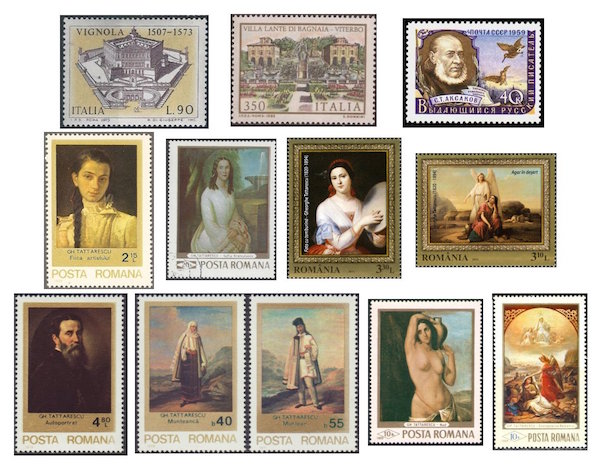
Speaking of Italy, we go there next. Giacomo Barozzi da Vignola (1 October 1507 – 7 July 1573) was one of the three great Italian architects, along with Michelangelo and Palladio, to inherit and develop the classical style of Vitruvius. Indeed, Vignola wrote a treatise called The Five Orders of Architecture based on the ancient Roman’s De Architectura. Vignola’s achievements are crowned by his Villa Farnese at Caprarano in northern Italy (not to be confused with the Palazzo Farnese in Rome). Vignola worked on this project from 1559 until his death. On another Italian stamp we see the Villa Lante at Bagnaia (begun in 1566), for which design Vignola may have been only partly responsible.
Russian writer Sergey Aksakov (ahk-SAH-kof; October 1 [O.S. September 20] 1791—May 12 [O.S. April 30] 1859) was born in Ufa, brought up on a country estate, and educated in Kazan. He was a lover of theater and moved in literary circles, publishing his first writings (poems) anonymously in 1812. Apart from his participation in that year’s military engagements with the invading forces of Napoleon, Aksakov led a mostly retired life, with some employment in civil service. A fervent admirer of Gogol, he wrote reviews, articles, stories, and his magnum opus, the semi-autobiographical A Family Chronicle (1856). He also wrote various memoirs and two much-admired books on hunting and fishing, both of which were favorably reviewed by Turgenev, and of which Gogol himself wrote in a letter, “Your birds and fishes are more alive than my men and women.”
Most sources are not specific regarding the precise birthdate of Romanian painter Gheorghe Tattarescu (1818 – October 24, 1894), but both French and Russian Wikipedia declare October 1, and that’s as good a date as any other for our purposes. Tattarescu had an uncle who was a church painter, and the young man received formal instruction in his homeland and in Rome. At thirty, he took part in the 1848 Revolution in Wallachia and subsequently painted a number of its champions in exile. He co-founded the National School of Fine Arts in Bucharest in 1864 and wrote a book on proportions of the human body the next year. Many of his works appear on stamps of Romania. Let’s begin with The Artist’s Daughter, Portrait of Sofia Kretzulescu (1852), and two quite recent (2015) stamps showing Girl with Tambourine and Hagar in the Desert. In the second row are a few stamps from 1979 set devoted entirely to Tatterescu’s work: Self-Portrait, Mountain Woman, and Mountain Man, then Woman Carrying Jug and The Reveille of Romania (1850).
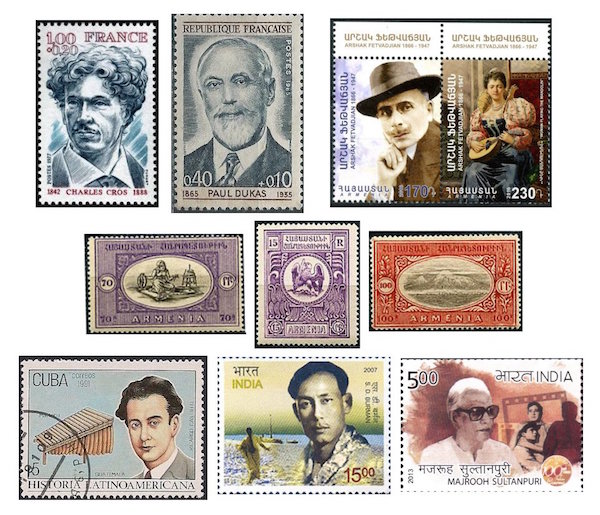
French poet and humorist Charles Cros (October 1, 1842 – August 9, 1888) contributed to the arts not only with his writings, but also as an inventor in the realms of sound and image reproduction. He conceived ideas for taking color photographs, transmitting graphics by telegraph, and recording sound, working on his so-called Paleophone at the same time as, but independently of, Thomas Edison, who got the job done first. His poems were well received, and one of them was set to music by Ernest Chausson as Chanson perpétuelle. Another song using lyrics by Charles Cros, “Sidonie“, with music by Jean-Max Rivière and Yanis Spanos, appeared in Louis Malle’s film Vie privée (1962) and was recorded by the film’s star Brigitte Bardot, whose birthday was a few days ago.
Paul Dukas (1865 – 17 May 1935) was a French-Jewish composer whose most famous work is The Sorcerer’s Apprentice (L’apprenti sorcier). Highly self-critical, he left behind only a rather small corpus of completed works, the most important of which are his symphony, the ballet La Péri, the opera Ariane et Barbe-bleue (Ariadne and Bluebeard), an expansive piano sonata, dedicated to Saint-Saëns, and the Rameau Variations, also for piano. (Dukas edited Rameau’s works with Saint-Saëns. I just posted the Rameau stamp on the 25th ult., and philatelic Saint-Saëns is coming up next week.) I found some interesting facts about Dukas, several of which I hadn’t known before. He showed no particular interest in music until he was 14, when he began composing while recovering from an illness. One of his friends at the Paris Conservatory was Claude Debussy. He began his career as a critic with a review of Wagner’s Ring as led by Mahler at Covent Garden! He succeeded Widor as professor of composition at the conservatory, and his roster of distinguished students includes Olivier Messiaen, Maurice Duruflé, Joaquín Rodrigo, Carlos Chávez, Manuel Ponce, Xian Xinghai, David Van Vactor, and two superb French organ composers, Jehan Alain and Jean Langlais. He received the dedication of Fauré’s Second Piano Quintet.
Armenian artist Arshak Fetvadjian (October 1, 1866 – October 7, 1947) was born in one of those cities the name of which used to conjure images of exoticism, Trebizond. He studied art in Constantinople and Rome, Vienna and Saint Petersburg. A highly productive worker, he held exhibitions not only in his homeland, but even at the Louvre and the Victoria and Albert Museum. After the fall of the Armenian republic to the Soviets, he emigrated to the United States and lived here from 1922. He died in Medford, Massachusetts. Fetvadjian was important as a documentarian, having made watercolor paintings of architectural monuments in Armenia, most notably in the city of Ani, prior to their destruction in the Russian Civil War. He was also one of the first artists to address the the Armenian Genocide on canvas. In addition to all this, he designed currency and postage stamps of the first Republic of Armenia (1918–20). Some of these are on display in the collage, along with a pair of stamps just issued last year for the sesquicentennial of the artist’s birth.
Ricardo Castillo (1891–1966) was a Guatemalan composer who lived in Paris from 1906 to 1922. On his return home, he taught harmony and composition at the National Conservatory. He music reflects a heady mix of impressionism, neoclassicism, and Mayan mythology! He had a brother Jesús who was also a composer. His major works are an Homenaje a Ravel (1920), Guatemala, symphonic movements (1934), a ballet, Estelas de Tikal (1948), a “ballet maya” called Paal Kaba (1951), the “symphonic evocation” Xibalbá (1944), and a Sinfonieta (1945).
Next we have two creative talents from India, both heavily involved with music for films. Earlier born was S(achin) D(ev) Burman (1 October 1906 – 31 October 1975), a composer. Burman first learned music from his father, a dhrupad singer and sitar player. After more formal training he sang on radio (1932) and made many recordings in Bengali. It was in the mid-1930s that he began composing, first for the theater. After his first hit in 1940 he was consistently in demand as a composer for the movies, though he moved to Mumbai in 1944 and took on work for Hindi films as well as those of Bengal.
Majrooh Sultanpuri (1 October 1919 – 24 May 2000), meanwhile, was an Urdu poet who also wrote lyrics for many songs in films. Cited as one of the finest of 20th-century poets in Urdu, he held sway as a doyen of Hindi film music in the 1950s and 60s. Earlier, even after his first great successes in the film industry, his leftist leanings (and lyrics) earned him a two-year jail sentence from 1949 to 1951. He later became disenchanted with Soviet and Chinese Communism. He frequently collaborated with the director Nasir Hussain.
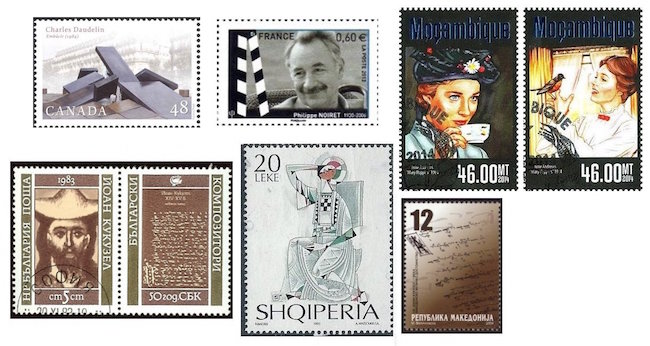
Québecois sculptor and painter Charles Daudelin (October 1, 1920 – April 2, 2001) created many public works including his bronze Polypède (1967) for Montreal’s McGill University, Éclatement II (1999), a fountain for Palais Station in Quebec City, and Embâcle (1984), as seen on the 2002 Canadian stamp, for the Place du Québec in Paris. An example of his two-dimensional work is Circuit 5 (ink on paper, 1994).
If only Richard Harris (1 October 1930 – 25 October 2002) had lived a bit longer, he’d be the Dumbledore on the Harry Potter stamp rather than Michael Gambon (whose birthday is on the 19th). There’s nothing for Walter Matthau (October 1, 1920 – July 1, 2000), either, but one actor who has achieved philatelic immortality was the unforgettable Philippe Noiret (October 1930 – 23 November 2006). He did not do well academically and turned to the theater, appearing on film for the first time (uncredited) in Gigi (1949). His film career didn’t really take off until 1960, after which he worked continuously for forty years plus. Noiret’s breakthrough role came with the 1968 comedy Alexandre le bienheureux (Very Happy Alexander). He won his first won César in 1976. My Philippe Noiret recommendation? Bertrand Tavernier’s Coup de Torchon (1981).
Julie Andrews was also born on October 1st, five years after Philippe Noiret. She was performing as a child as early as 1948 and was making waves on Broadway by the time she was 19. I’m surprised there seem to be no stamps for The Sound of Music, but her image appears on a Mozambique set for Mary Poppins. Happy birthday, Julie Andrews!
Octobert 1st is also the Feast Day of John Koukouzelis (Kukuzel; c. 1280 – c. 1360), a medieval Bulgarian composer and Eastern Orthodox saint. Kukuzel was born a subject of the Byzantine Empire in its waning days (less than two centuries later it would fall to the Ottoman Turks and be renamed Istanbul). He is regarded as Bulgarian despite having been born in Durazzo (now Durrës in Albania) to an Albanian father (his mother was Bulgarian). Koukouzelis studied at court in Constantinople and developed into a singer and reformer of Orthodox Church music as well as a composer in that tradition. He “established a new melodious (‘kalophonic’) style of singing out of the sticherarion”, says Wikipedia. I’ll leave it to others to pursue that abstruse knowledge in their own time. I read that he was a favorite of the emperor, but couldn’t determine which of three contemporary monarchs was the emperor in question (Andronikos II Palaiologos, 1282–1328; or Andronikos III Palaiologos, 1328–1341; or John V Palaiologos, 1341–1376). At some point Koukouzelis removed to Mount Athos. I don’t know in what year he was recognized as a saint. Today there is a musical school his native Durrës. The stamp issues come from Bulgaria (with label, at left), Albania, and Macedonia.
A graduate of the University of Massachusetts with a B.A. in English, Doug Briscoe worked in Boston classical music radio, at WCRB, WGBH, and WBUR, for about 25 years, beginning in 1977. He has the curious distinction of having succeeded Robert J. Lurtsema twice, first as host of WGBH’s weekday morning classical music program in 1993, then as host of the weekend program when Robert J.’s health failed in 2000. Doug also wrote liner notes for several of the late Gunther Schuller’s GM Recordings releases as well as program notes for the Boston Classical Orchestra. For the past few years he’s been posting a Facebook “blog” of classical music on stamps of the world, which has now been expanded to encompass all the arts for The Arts Fuse.
